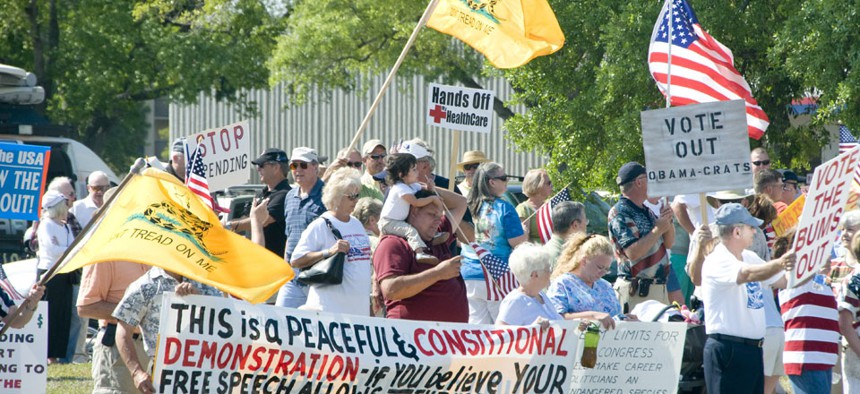The GOP Still Hasn't Figured Out How to Get On With the Tea Party
Tuesday's election results ensure that the battle over the faction's role in Republican politics will rage on.
Postmortems of odd-year and special elections often suffer from overly broad generalizations that push a particular narrative while overlooking any arguments that get in the way. The instant analyses also tend to suffer from the impulse to extrapolate results and divine great meaning, as if they foreshadow the future. I’ll try to avoid both temptations in offering a few observations about Tuesday’s outcomes.
Was Virginia gubernatorial candidate Ken Cuccinelli an ideal candidate for the GOP to run in an increasingly purple state? No, but neither was Terry McAuliffe for the Democrats. Cuccinelli was very strong among the most ideological of Republicans, but less so with the old-line Republicans, the members of the establishment and the business community who were uncomfortable with his long-standing and very strong emphasis on social and cultural issues. In the end, these social issues hurt Cuccinelli in the rapidly growing suburbs of Northern Virginia. Conversely, McAuliffe was very strong among the Democratic Party establishment but less popular among the more ideological Left in the party. The 2008 split between supporters of Hillary Rodham Clinton and Barack Obama is an apt comparison for describing the internal division that McAuliffe faced early on. But liberals’ antipathy toward Cuccinelli repaired that rift.
Neither Cuccinelli nor McAuliffe had a natural claim on voters in the ideological middle. Looking at polls from late spring and early summer, Cuccinelli led in some, McAuliffe was ahead in others, but the race was pretty even at that time. Starting in mid-July, however, the pattern changed dramatically. After a July 8-14 poll by Roanoke College that put Cuccinelli ahead by 6 percentage points, the next 38 polls leading up to Election Day had McAuliffe ahead, some by just 1 or 2 points, others by 10 or 12 (one by 15 points). McAuliffe’s consistent lead in the surveys began at roughly the same time as Republican Gov. Bob McDonnell’s ethics problems. Combine a weak candidate with a governor under criminal investigation, and it was more than the campaign could withstand. If Cuccinelli were a less threatening candidate to suburban swing voters, he might have survived McDonnell’s problems, but he wasn’t and thus couldn’t. Both sides ran very competent campaigns, it should be noted, and neither candidate committed any significant faux pas.
Did the disastrous rollout of Obamacare hurt Democratic candidates, dampen party enthusiasm, and cost McAuliffe and other Democrats on the ticket momentum and support? It’s certainly plausible, maybe even likely, but it is unclear to what extent that was the case. The exit-poll results aren’t decisive on this point, and while public polling suggested that in the last week or two of the race Cuccinelli gained more points out of the previously undecided column than did McAuliffe, it’s not absolutely clear that Obamacare caused the shift.
Toward the end, the HuffPost Pollster average in Virginia showed a McAuliffe lead of 7.2 percentage points. One thing that political aficionados should have learned from Nate Silver in 2012 is to watch for patterns as much as point spreads. When a lot more polls show Smith ahead of Jones, even though most of the leads are very small, even within the margin of error, the odds are pretty good that Smith will win—maybe by a little, maybe by a lot, but the probabilities are on Smith’s side. In this case, McAuliffe was Smith, and although the 3-point winning margin may not have been as wide as many expected, the outcome was as predicted. Private Democratic polling was reportedly showing McAuliffe ahead by 2 to 4 points, bracketing the eventual 3-point spread.
One takeaway is that while McAuliffe ran up slightly higher margins among Democrats and liberals than Cuccinelli did among Republicans and conservatives, the fact that Cuccinelli could win the independent vote by 9 percentage points yet lose the election by 3 points is a reminder that the gap between self-identified Democrats and self-identified Republicans is getting so wide that, in many races, winning the independent vote isn’t enough for a Republican candidate to bridge the gap. Remember that Mitt Romney won the independent vote last year by 5 points but still lost the election by almost 4 points. Brand damage has hurt the GOP in party identification, and that, in turn, is hurting Republicans on Election Day.
In New Jersey, Republican Chris Christie won as expected, with margins that were as broadly spread among demographic groups as they were deep. His 22-point victory in a Democratic state should be a lesson for his party: A Republican who is moderately conservative on economic issues and doesn’t emphasize social issues, even if he is relatively conservative, can win in enemy territory. Christie didn’t walk away from conservative voters and values, but neither did he try to shove his conservatism down the throats of moderate swing voters.
In Alabama’s 1st Congressional District, the win by the business-establishment-supported Bradley Byrne over tea-party-supported Dean Young is the Fort Sumter of a civil war that will rage over the next couple of years for the heart and soul of the GOP. Establishment and business-oriented Republicans—call them the “country-club set”—were the beneficiaries and sometimes enablers of the tea-party movement, until the tea party went too far and started causing the Republican Party major problems. Outside of a special kind of year like 2010, swing voters don’t go for the tea-party agenda in swing states and districts. But this war will go on; Alabama 1 didn’t settle anything. Republicans have to figure out who they are and who they want to be. The struggle between the Republicans who go to Sunday school on the Sabbath and the ones who head for the golf courses and tennis courts isn’t over.
(Image via Cheryl Casey/Shutterstock.com)







